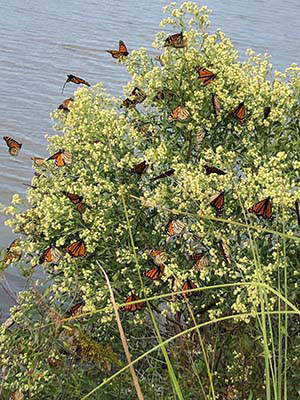Wendy's Wanderings
October 7, 2021
Monarchs on the Move
A while back I was presenting a butterfly gardening program to a garden club meeting in Gainesville when a person asked, "How long do butterflies live?" I gave the standard response of 2-6 weeks, to which the person responded, "What about the monarch butterflies that migrate?"
Yes indeed, what about the monarchs that migrate to Mexico to overwinter? I wasn't positive, so I gave our standard answer, "I don't know but I will find out." I did the research and got the answer. Migrating monarch butterflies live up to eight months. As good questions from gardeners often do, this query opened the door for many other questions about monarchs and their migration and inspired me as well.
Every fall millions and millions of monarch butterflies depart from their breeding grounds in North America and head south to the Transvolcanic Belt, in an area 100 miles west of Mexico City. For some, this journey can be as far as 3,000 miles. The long-lived generation of monarchs that migrate are stouter and have more scales; they beef up on milkweed and nectar plants, both in nature and in our butterfly gardens, to make the journey. An amazing fact is that no butterfly that makes this migration has ever made the trip before. Migrating monarchs are strong flyers and can travel for 11 hours straight, using the air currents to go as far as 620 miles without feeding. Some oil rig workers in the Gulf of Mexico have even observed groups of butterflies resting on their structures before they continue their travels to the mountains of the Sierra Madre Oriental, in the state of Michoacan, Mexico. When the butterflies reach the overwintering sites, they settle in the high-altitude coniferous forests primarily made up of oyamel firs. Here they experience a temperate protective climate where they enter a state of rest and reproductive diapause. They do feed and drink when the sun shines but return to the fir trees to roost. Monarchs remain for up to four months in this state, then breed and begin to migrate north. In the northern direction it takes several generations of butterflies to repopulate the breeding grounds in North America.

Monarch butterflies on saltbush at St. Marks National Wildlife Refuge, October 2019. Wendy Wilber, UF/IFAS.
The question from a curious garden club member inspired me to make my own migration to see the overwintering monarchs in Mexico. Hosted by the Florida Museum of Natural History, the trip was a breathtaking experience. Our small group of travelers saw millions of butterflies across two butterfly sanctuaries, and we had lepidopterists on hand to answer our many questions. Now it is hard to see a monarch in October and not wonder when they will begin their journey. Every year in late October numbers of monarchs congregate along the coast in Wakulla County Florida to take flight across the Gulf of Mexico, headed for Michoacan. I try to make it over to St. Marks National Wildlife refuge there to see a few of them off and to remember my special trip to the butterfly sanctuaries in Mexico.
You may have read in the news that monarchs need our help. Climate change, loss of habitat, and increased use of insecticides are serious challenges for the monarch population. Do what you can to plant native plants—specifically their larval host milkweed—and try to eliminate pesticide use in your landscape. Many of you already have butterfly gardens and even have "Monarch waystations." Take it a step further and educate your neighbors about monarchs and butterflies. Include butterfly education in your outreach and use websites for information like Ask IFAS, Monarch Watch, and the Xerces Society. Perhaps if you are inspired to do your own migration, take Florida Museum of Natural History's guided trip to Mexico to experience the monarch-overwintering wonder yourself.
-- Wendy Wilber

